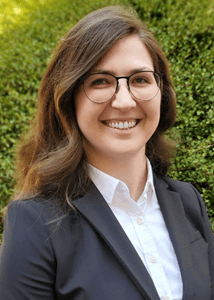Rita Somogyi sees a lot of similarities between the operating room and the fencing strip.
As a D1 student-athlete at Duke University, Somogyi had plenty of opportunities to practice the lunges and attacks it takes to be a talented fencer. She continued her education at Oregon Health and Science University’s School of Medicine; and while earning her MD, she learned the same savvy was needed to be a skilled surgeon.
Whether she’d be holding an epee or a scalpel, Somogyi likes situations that keep her on her toes and moving quickly. She likes being part of a team that can win in competition or work together to find solutions to patients’ problems.
Somogyi is one of six first-year residents joining the Indiana University School of Medicine Department of Orthopaedic Surgery this summer to continue their medical training.
The Department of Orthopaedic Surgery residency program offers two tracks of training: a five-year clinical track and a six-year research track. The physician-learners who join the program will build upon the knowledge and skill sets obtained in medical school while preparing for independent practice.
Orthopaedic residency training focuses on clinical skills and compassionate patient care; achievement of professional competencies; acquisition of medical knowledge; and achievement of scholarly activity through research.
Those who join the research track follow the same training as the five-year clinical track but spend one year after the PGY 2 year conducting research within the lab. The research track resident will resume as a PGY 3 clinical trainee after the research year.
Somogyi will be a clinical track resident. She said she didn’t originally have much interest in a medical career. But her father – who is a gastroenterologist in her home state of Oregon – proposed the idea about halfway through her undergraduate years of study.
He pointed out their similar personalities and interests, she said, and suggested she might enjoy working as a doctor as much as he did. So, Somogyi started job shadowing doctors and quickly discovered that her father was right.
Amid the moments of mentorship during her job shadowing, Somogyi discovered that the quick thinking she used in fencing and the teamwork she loved about the sport carried over well into a clinical setting. Somogyi took up fencing around middle school and it quickly became a passion that carried her all the way to a captain’s position at Duke University. She described it as “a game of physical chess” and said it helped her develop “discipline, patience, critical thinking, precision, and coachability” – all skills that make for a talented doctor.
A career in orthopaedics meshed well with Somogyi’s passion for sports. Orthopaedic surgeons often treat athletes; and it is gratifying to help patients quickly return to the activities they love, she said.
Somogyi is eager to begin her residency at IU and said the department’s program ticked important boxes in her search for the best place to continue her medical education.
She appreciated that the Department of Orthopaedic Surgery has a strong female presence within its residency program. She also liked that the medical campus and academic campus at IU in Indianapolis feels very integrated; she enjoys serving as a mentor and knows being near young medical students will foster those mentorship opportunities.
Somogyi and her fellow PGY 1 residents will join the department in early July.
